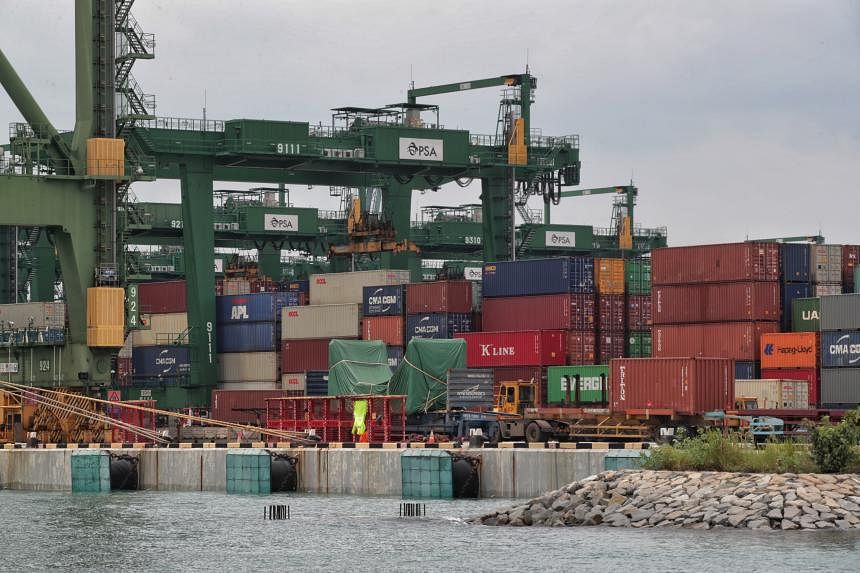SINGAPORE - Singapore’s key exports made a good start to the year with a better-than-expected performance in January, though economists warned of a bumpy road ahead.
Non-oil domestic exports (Nodx) rose 16.8 per cent in January 2024, led by a jump in shipments of specialised machinery to make semiconductors, and non-monetary gold, data from Enterprise Singapore (EnterpriseSG) on Feb 16 showed. But it was from a low base, as Nodx in January 2023 fell 25.1 per cent year on year amid the Chinese New Year period.
The expansion in January came after a 1.5 per cent drop in December, and exceeded the 4.3 per cent growth forecast by economists polled by Bloomberg.
At $13.2 billion, the January 2023 shipments were below the monthly average of $14.4 billion for the year, EnterpriseSG said in its release on Feb 16.
However, economists were heartened to see that on a month-on-month seasonally adjusted basis, Nodx rose 2.3 per cent in January after the 1.7 per cent decline the previous month.
“This brings Nodx seasonally adjusted levels to $14.9 billion in January 2024, the highest since April 2023,” said DBS economist Chua Han Teng.
Both electronics and non-electronics exports grew. Notably, exports to China surged 101.3 per cent, driven by specialised machinery, non-monetary gold and measuring instruments.
Non-electronics Nodx surged 21.2 per cent from a year earlier, extending the 1.4 per cent growth in December. Its growth was driven by specialised machinery, non-monetary gold and pharmaceuticals.
EnterpriseSG told The Straits Times that the largest contributor to January’s Nodx growth in terms of absolute monetary value was specialised machinery, which grew $800 million or 41.1 per cent compared with a year ago. This was followed by non-monetary gold, which rose by $600 million, or 198.7 per cent.
Exports of chipmaking equipment rose in tandem with the expected pickup in global electronics recovery, the agency said.
Unlike monetary gold exchanged among central banks worldwide, non-monetary gold refers to all other types of gold in circulation. It can take the form of coins, ingots, bars or powder.
According to the World Gold Council, jewellery accounts for half of the total gold demand. Gold is also used as an industrial metal, and most types of semiconductor chips use it either as a coating or thin bonding wires.
Electronics exports increased by 0.7 per cent in January, after an 11.7 per cent contraction the previous month.
Leading the way were shipments of printed circuit boards, which rose 34.3 per cent, followed by diodes and transistors (up 9.3 per cent) and personal computers (up 5.7 per cent).
Compared with a year earlier, total trade expanded by 14.1 per cent in January, after the 6.8 per cent decline in December.
EnterpriseSG had on Feb 15 upgraded its full-year 2024 forecast for Nodx to 4 per cent to 6 per cent growth, up from an earlier estimate of 2 per cent to 4 per cent. The upgrade is premised on projections of a gradual recovery in global electronics demand.
Mr Alex Holmes, lead Asia economist for Oxford Economics, said: “We suspect there are two factors at play here. The first is cyclical. The global electronics cycle has bottomed out and demand is now rising. There’s replacement demand from consumers for those items they bought during the pandemic, while some businesses are investing heavily in chips again to ride the artificial intelligence wave.
“The second is likely more structural. We had highlighted previously that Singapore seems to be benefiting from shifts in electronics trade flows, though recent experience has shown this as volatile, rather than sustained.”
Mr Holmes said that while, overall, the trend in exports has clearly improved, there is still reason for caution.
“First, this is being more driven by re-exports. More highly value-added domestic exports have been roughly flat over the past few months. Second, while the outlook for global demand is looking better, it is nonetheless subdued, with global growth set to be weak at 2.4 per cent.
“Therefore, we expect a positive but not transformational boost to gross domestic growth from Singapore’s external sector this year.”


